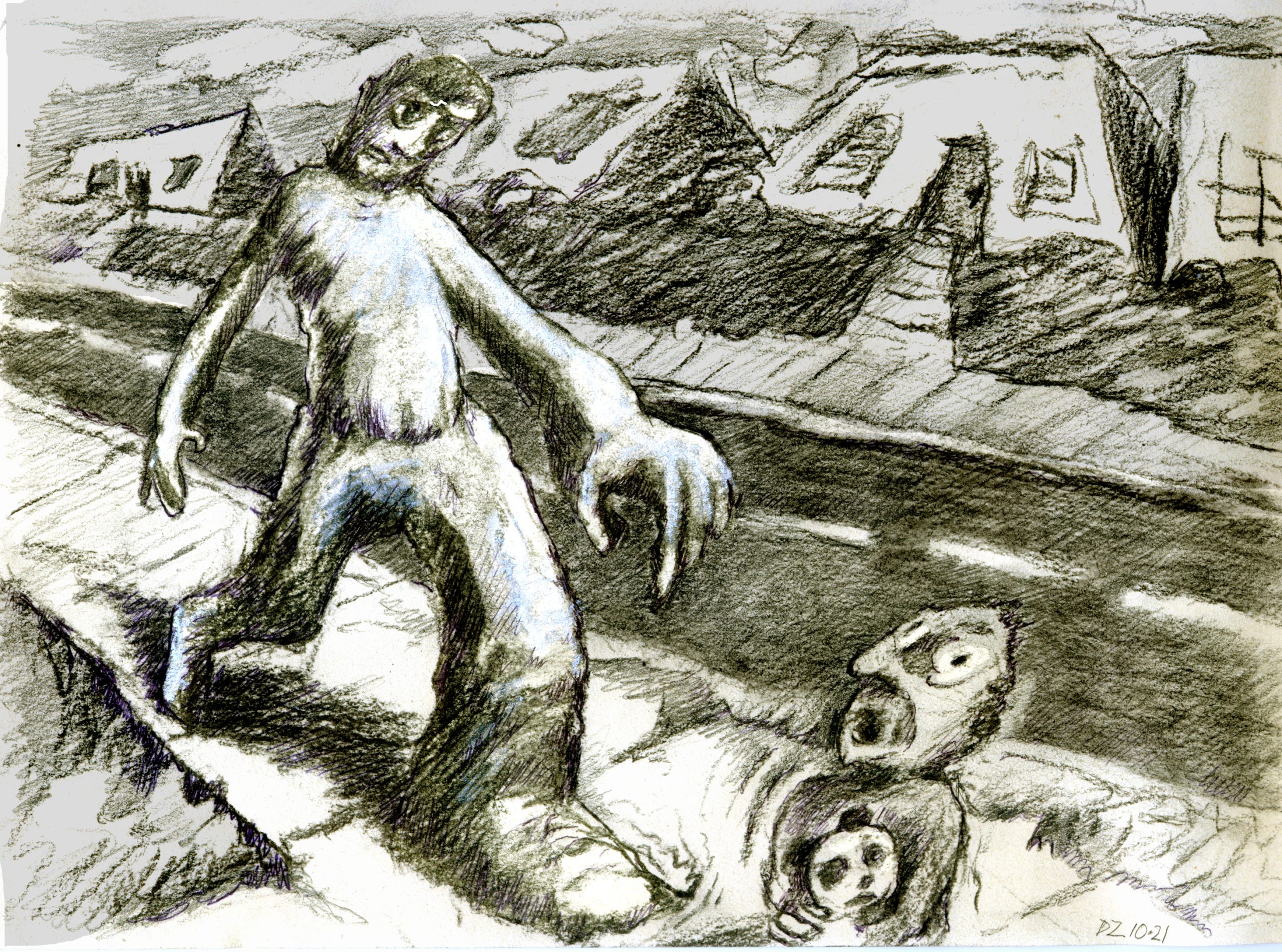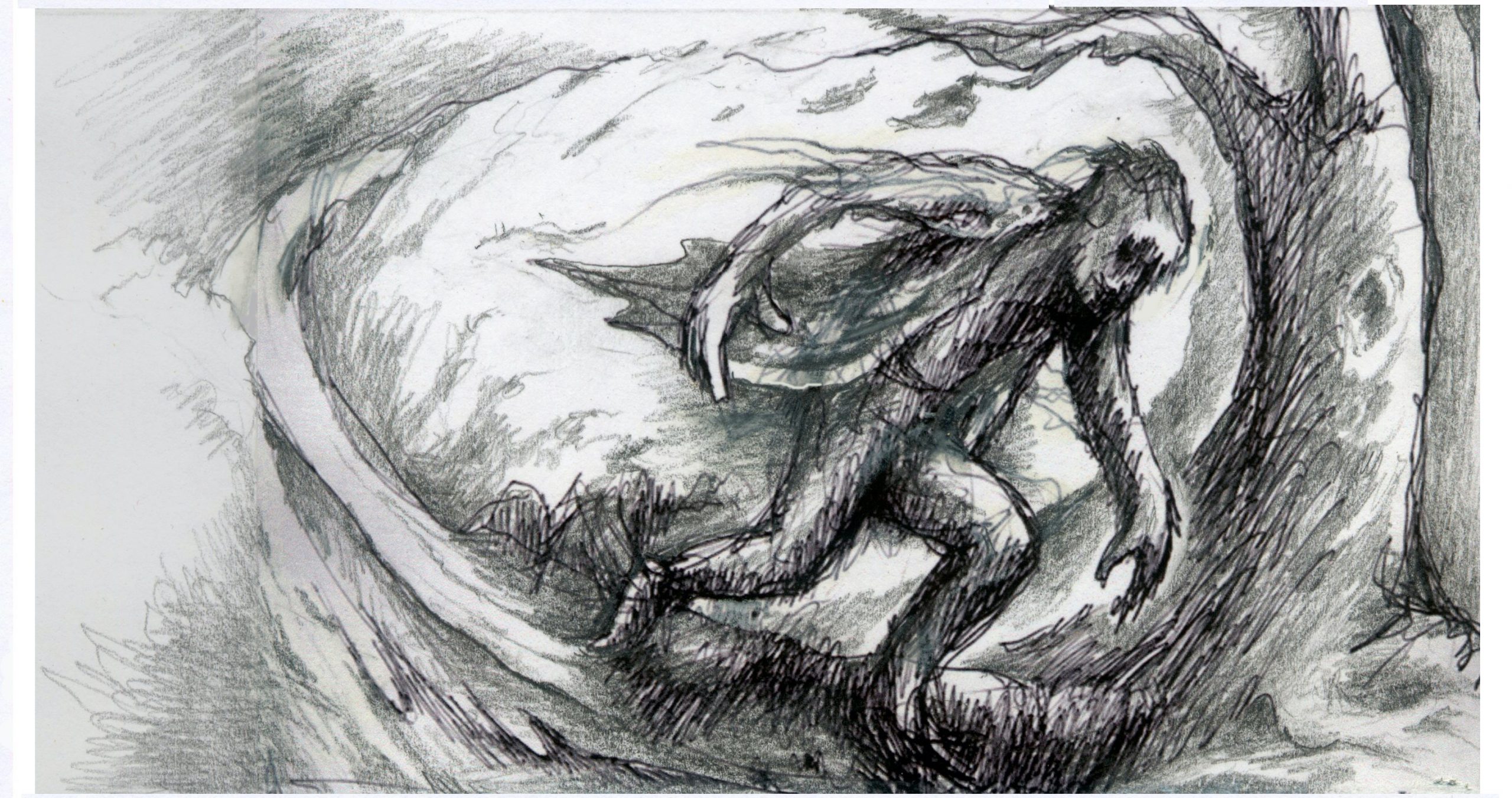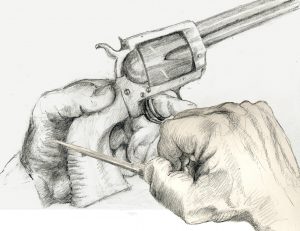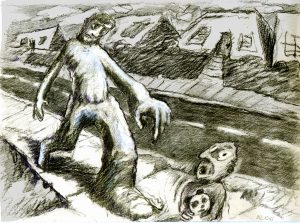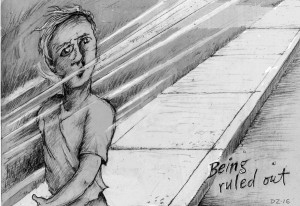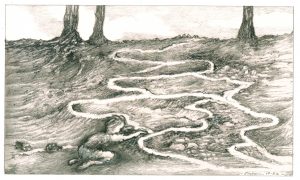The Ghost Town, or Corriganville, Old Tucson and Bodie
[Once again, my longtime compadre of creativity, Dan Zimmerman combines text and his superb drawings to reflect upon life, death, memory, and art.
Let those who have eyes and those who have ears, see and hear…
All drawings by Dan Zimmerman.
Dr. David W. Robinson, Ye Olde Editor]
My dad taught me to love the "oaters" when we lived in San Luis Obispo and Los Angeles. After the extensive work he always did preparing sermons and then preaching them every Sunday, he would come home tired, turn on the television set, relax in his chair, and watch The Lone Ranger, The Three Mesquiteers, Hopalong Cassidy, or some other hard-riding, hard-fightin' star like Kermit Maynard or Buck Jones. Of course, there were also the singing cowboys. One of my earliest memories was Gene Autry in Phantom Empire, which combined western, musical and science-fiction elements.
On "family days," in the fifties and very early sixties, Dad liked to take us out to the Simi Valley area where the westerns were filmed. Corriganville was a town they had built on the property of Ray "Crash" Corrigan. Ray, along with Bob Livingstone and Max Terhune, was one of The Three Mesquiteers. He was also the guy who was inside the terrifying alien suit in It, the Terror from Beyond Space.
Corriganville Movie Ranch was open to the public on weekends. All around it, of course, was country very familiar to my imagination. Its roads wound through low-lying oaks which cowboys jumped up into or leapt out of, past magnificent rocks which they clambered over or used as cover to shoot from. I loved climbing around this terrain. Later it made watching the movies even more exciting.
One weekend that we went, I saw Robert J. Wilke standing by his car in the parking lot. You'd recognize him if you saw a photo. He was the guy who fought with Kirk Douglas when water was flooding into the Nautilus at the climax of 20,000 Leagues Under the Sea. I'm guessing he might have been out there working on Have Gun Will Travel, which was also shot there.
In 1963 Tucson, we lived on Painted Hills Road, which intersects West Speedway beyond the edge of town. It was actually the only house my parents ever owned. Before that they had inhabited a string of parsonages going back to the first days of their marriage.
I loved it out there. We kids used to catch the bus to school right at the corner of Painted Hills Road and Speedway. The rolling hills all around were thickly populated with cacti, stands of saguaro, ocotilla, prickly pear, barrel, and the tenacious cholla. Of course, there were also rattlesnakes and scorpions to watch out for, as well as prairie dogs, roadrunners, herds of javelina and more. Marvelous stuff! We saw a bobcat in our driveway soon after moving in, and my brother, Mike soon brought a tarantula home in a jar from the arroyo near our house.
Things had changed. Before, in California, I rode my bike on a regular basis on city streets, delivering newspapers and hauling my skimboard to the beach. Now that I was a desert dweller, I did my riding on dirt roads, to explore my new turf, and get in shape for football and wrestling.
One day I biked up into the mountains behind my house, out Speedway and over Gates Pass, a low ridge at the western edge of the Tucson basin. On the other side you could see Old Tucson on the plain below, constructed for the Columbia picture Arizona in 1940. It was built to look like the mud-adobe town Tucson used to be.
As the years went by Old Tucson had been further developed. It was a picturesque replica of a western town, complete with raised wooden sidewalks, a grandiose hotel and saloon, a sheriff's office, blacksmith's shop, old white-washed Spanish-style church and, of course, dirt streets to handle both stagecoach and horse traffic, complete with tethering posts and water troughs.
In my case, I didn't need a horse. I looped down over the pass, scooted left into an arroyo which crossed the road, hid my trusty bike behind a mesquite tree..and quietly walked into the back side of the movie lot.
I have a friend from Tucson High, whom I played football with there, whose parents, the Sheltons, owned Old Tucson. I remember a hallway in his house lined with photos of Robert Shelton with John Wayne (Rio Bravo), Kirk Douglas (Gunfight at O.K. Corral), Jimmy Stewart (Winchester 73) and other stars. When I recently talked to my old friend on the phone and told him about my going in the back way, he said, "You owe me!" It was a justifiable reaction on his part, as well as a good reason to laugh together.
In 1968, Heaven with a Gun, a western starring Glenn Ford was about to be filmed at Old Tucson. My father had been contacted by someone from the press about posing for a publicity shot. They thought it would excite interest locally if they photographed a real preacher from present-day Tucson shaking hands with Ford, who would portray the gunman-turned-preacher in the film. Dad asked me if I wanted to go. "Sure," I said.
I've never seen Heaven with a Gun. But Glenn Ford is not the important figure in this piece. Oh, I met him that day, yes, but he seemed like kind of a jerk. To be fair, maybe he thought I was a teenage punk. Not to digress, though.
My father has always been the hero of the story for me. Like Ford's character, he always strove to stand up for the dignity of others. So, it strikes me as particularly poignant that he chose to leave his wife and children at the same time he was posing for that publicity shot at Old Tucson. The Zimmerman family was going through a period of great structural stress. 1662 Painted Hills Road would turn out to be the last place we lived as an intact family. This particular family crisis culminated in Dad making the decision leave the ministry, move back to California, and divorce my mother soon thereafter. Except for this one egregious case, I believe my father usually fought a noble fight in life.
I still maintain that, in one way or another, he was always engaged in what had been for him a lifelong struggle with the reality of death. The death of his father when he was 6 in Duluth, Minnesota was something he could never wholly accept. I think he was always haunted by it.
Speaking of being haunted, he also liked to take our family to visit ghost towns. The most memorable for me was our trip to Bodie, a ghost town east of Yosemite near the Nevada line, still preserved today "in a state of arrested decay." I recall my parents being careful to tell us how we should take care where we stepped around the old buildings, so we wouldn't fall through a rotten floor and be sorry.
Bodie was indeed a haunting place. But in a related sense, so were Corriganville and Old Tucson. They were reminders of the inevitable transience of life and the ever-present specter of death. In 1995, a tragic fire consumed much of Old Tucson. We visited recently, but it was closed. The familiar mountain one sees in all the films, however, still looms over the scene. You could feel the presence of everything that had taken place there.
Such spots are the repositories of myth, symbols of our quest for a fresh realization of life passed by too quickly.
Emile Zola wrote that through art we "objectify the subjective," that art is "the exteriorization of an idea." It could be that when I was visiting these ghost towns I began to see some of the ideas I was meant to exteriorize. I began to encounter the compelling realm of myth and symbol. As a boy growing up where people were busy giving their dreams shape, so near Hollywood, which was often called a "dream factory," something stirred deeply in my imagination.
I wasn't convinced... I've NEVER been convinced that life was as it appeared outwardly to be, in the streets and neighborhoods where I lived. Everyday life wasn't telling me the whole story.
Civilization has a way of shielding us from the uncomfortable but revelatory reality of death.
A person can only see its secrets if he makes a myth of it somehow, to facilitate the looking. I'm still trying to exteriorize its hiddenness through creative work. Otherwise one might as well just be strolling down a nondescript street peering through the windows of other people's houses.
I create to disclose life.
And so this time I've told a tale of ghost towns. I'm very much like my father. He wouldn't settle for the way things appeared to be, either. From the day his dad died when he was 6 I think he lived on the edge, where meaning is sometimes brought into focus by the proximity of death.
As Nicolas Berdyaev says, "The fact of death alone gives true depth to the question as to the meaning of life. Life in this world has meaning just because there is death."
Dan Zimmerman: A Self-Portrait









